The Masonic Pillars
The pillar or column is perhaps the most fundamental structure in classical architecture. It originated from a simple post and lintel system which has been used for thousands of years. A very early example of this system is the famous Stonehenge in Wiltshire, England dating back to as early as 3000 BCE. Since this ancient structure, the post and lintel system has become more and more elaborate, eventually developing into the order, or style, of columns which we have today. The Greek and Roman columns serve the practical purpose of holding a building erect, while simultaneously contributing abundant beauty and order.
The Five Noble Orders of Architecture
As every Fellow Craft knows, there are five orders of columns in classical architecture: Tuscan, Doric, Ionic, Corinthian, and Composite. These classical column styles range from simple to complex in the following order:
Tuscan
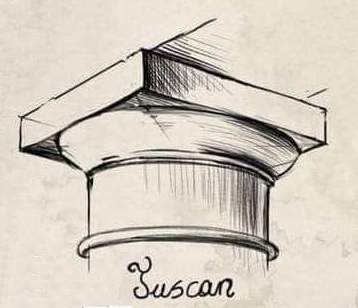
The Tuscan order is so called due to its origination in Tuscany in Italy and is the simplest of the orders, one step up from the plain post and lentil system of Stonehenge. This is supported by the famous architect Andrea Palladio in the words, “The Tuscan order, according to what Vitruvius writes of it and what it is in effect, is the plainest and most simple of all the Orders of Architecture because it retains more of the ancient simplicity of the first architects, who had not yet invented those ornaments that render the other orders so pleasant and so worthy of consideration.”
Tuscan columns originated during the Roman period, around the 6th century BCE. They were commonly used in military architecture, temples, and utilitarian buildings due to their sturdy nature. They were also favored for their minimalistic aesthetic, which aligned with the more functional needs of certain types of buildings.
A famous example of the Tuscan order can be seen in the Colosseum in Rome, where the lower level is adorned with these columns, showcasing their enduring strength and simplicity.
Doric
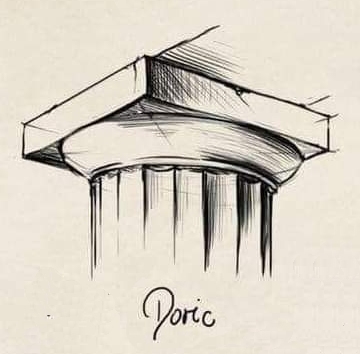
The Doric column is known for its sturdy, fluted shaft and simple, rounded capital. It is the oldest and most robust of the classical orders, often described as having a masculine quality due to its strength and lack of elaborate decoration.
The Doric order originated in ancient Greece, particularly in the Dorian regions, around the 7th century BCE. It was the preferred style for many of the period’s monumental buildings and was later adopted by the Romans.
Doric columns were primarily used in temples and structures that required a sense of grandeur and solidity, such as the Parthenon in Athens. The Parthenon remains the most iconic example of the Doric order, with its massive columns standing as a testament to the architectural ingenuity of ancient Greece.
Ionic
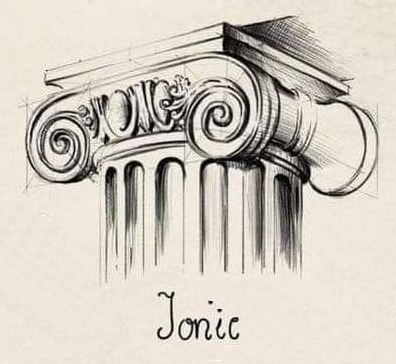
Ionic columns are easily recognized by their slender, fluted shafts and distinctive scroll-like volutes on the capital. This style is more elegant and decorative compared to the Doric order, often associated with a more feminine aesthetic.
The Ionic order originated in the Ionian region of ancient Greece around the 6th century BCE. It quickly became popular for buildings that required a touch of grace and refinement.
Ionic columns were frequently used in temples dedicated to goddesses, such as the Temple of Hera on the island of Samos. Another renowned example is the Erechtheion on the Acropolis of Athens, where the famous Caryatids (sculpted female figures serving as columns) are also found, further enhancing the elegance of the Ionic order.
Corinthian
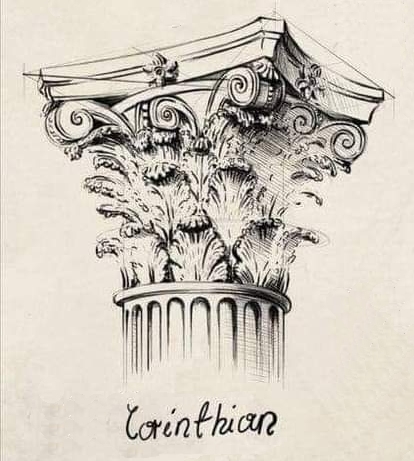
The Corinthian, originating from Corinth and the Composite order are the most extravagant of all the others. According to legend, acanthus leaves which were left underneath a basket on a young girl’s grave started growing around and engulfing the basket. The appearance of this occurrence served as the inspiration for the Corinthian capital. Palladio calls this order, “more gentile, rich, and beautiful, than any of those I have yet discoursed upon.”
The Corinthian column is the most ornate of the classical orders, characterised by its slender, fluted shaft and elaborate capital adorned with acanthus leaves and scrolls. This style exudes a sense of richness and splendor, making it the most decorative of all the classical columns.
The Corinthian order was developed around the 5th century BCE and became especially popular in Roman architecture. Its intricate design was often employed in temples, public buildings, and monuments to convey a sense of luxury and sophistication.
One of the most famous examples of Corinthian columns is the Pantheon in Rome. The Pantheon’s grand interior, with its rows of Corinthian columns, showcases the grandeur and beauty that this order can bring to a structure.
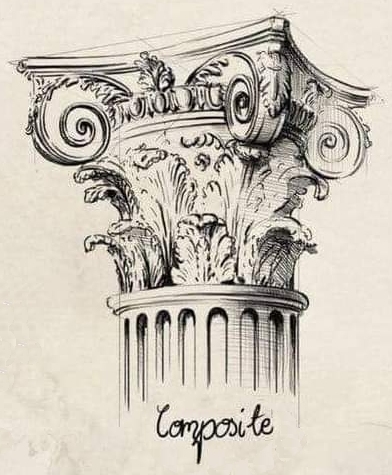
Composite
The last of the orders, the Composite order, is a combination of Ionic and Corinthian; and although it is just as magnificent, this order is found less in classical architecture compared to the Corinthian.
The Composite column combines elements of both the Ionic and Corinthian orders, resulting in a style that is elaborate and versatile. The capital of a Composite column features the volutes of the Ionic order atop the acanthus leaves of the Corinthian, creating a richly detailed and intricate design.
The Composite order was developed during the Roman Empire, around the 1st century CE, as an evolution of the earlier classical styles. It was intended to showcase the architectural advancements and artistic creativity of the Roman period. Composite columns were used in triumphal arches, basilicas, and other grand structures where a sense of opulence and grandeur was desired. A well-known example of the Composite order is the Arch of Titus in Rome, where the columns add to the monument’s regal and celebratory appearance.
The hierarchical order of the columns
The column has developed throughout history from a simple post and lintel system to the complex Corinthian order. This is not to say, however, that those simple forms are not still used today. Church architects use the hierarchy in the order of columns to reflect the hierarchy of importance in the different parts of the church.

In Catholic churches, this means all columns should be of an order that will direct the attention of the congregation to the tabernacle, which is the focus and purpose of the whole structure. The baldacchino, which is a canopy-type structure over the altar, is almost always supported by Corinthian columns, signifying the importance of the altar where the sacrifice of the mass takes place; The Basilica of St. Peters in Rome is a beautiful example of this. Some architects use a simpler order throughout the church and use the Corinthian order for the altar, to communicate a greater contrast of importance. The Basilica of Santa Maria in Rome uses the Ionic columns to line the aisle which terminate in the elaborate Corinthian columns of the baldacchino which mark the sacred altar. Ultimately, the orders of columns are used to direct the congregation in their earthly journey toward the adoration of the Blessed Sacrament which reflects their spiritual journey toward their ultimate end, namely Paradise.
Apart from religious structures, columns can be found in a number of other buildings including civic structures, libraries, theaters, and museums which follow the orders of columns. One example of a Library is the feature image of the Barker Library at the Massachusetts Institute of Technology.
Thus, basic columns in classical architecture have been developed over thousands of years into the five orders we have today. These not only contribute strength and beauty to a structure, but, through the hierarchy found in them, the orders of columns reflect the hierarchy of the structure as a whole.
![]()
